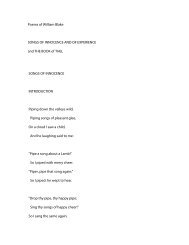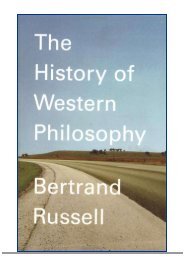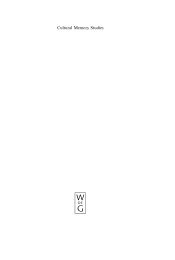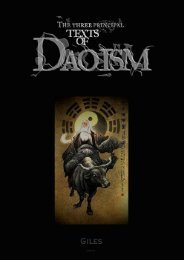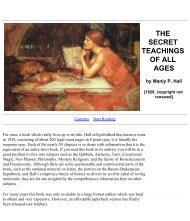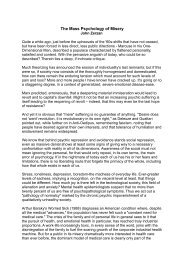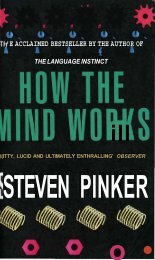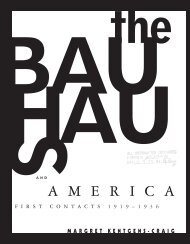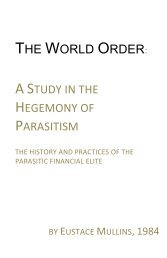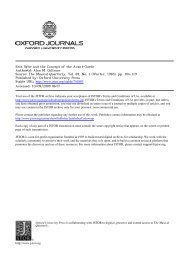concretion of space, our epoch is concerned with the concretion of time.And our fundamental point of departure, the attempt to concretize timeand thus realize and become conscious of the fourth dimension, furnishesa means whereby we may gain an all-encompassing perception andknowledge of our epoch.<strong>The</strong> early years of the Renaissance, which one might even characterize asbeing dramatic, are the source of further writings in the wake of Cennini'streatise. Of equally epochal importance are the three volumes of LeonBattista Alberti'sDellapittura of 1436,which, besides a theory ofproportions and anatomy based anVitruvius, contain a first systematicattempt at a theory of perspectival construction (the chapter "Dellaprospettiva"). Earlier, Brunelleschi had achieved a perspectivalconstruction in his dome for the cathedral of Florence, and Manettijustifiably calls him the "founder of perspectival drawing." But it wasAlberti who first formulated an epistemological description of the newmanner of depiction, stated, still in very general terms, in the words:"Accordingly, the painting is a slice through the visual pyramidcorresponding to a particular space or interval with its Center and specifichues rendered an a given surface by lines and colors." What Vitruvius inhis Architettura still designated as "scenografia" has become for Alberti a"prospettiva", a clearly depicted visual pyramid.Some dozen years later, the three Commentarii of Lorenzo Ghiberti alsotreat of this same perspective; but despite his attempt to remain withinthe tradition, his treatises describe in a novel way not only perspective butalso anatomy and a theory of drawing (teorica del disegno). It is significantthat he corrects his principal model, Vitruvius, by inserting a chapter an"perspective" where Vitruvius would have included a chapter an the"knowledge of rules," and consequently intentionally 'elevatesperspectivity to a basic axiom of his time.<strong>The</strong>re is yet another major artist of that age who continues the discussionof this subject in advance of the definitive statements of Leonardo. Towardthe end of his life, Pierodella Francesca furnishes a penetrating theory ofperspective compared to which Alberti's seems amateurish and empirical.In his three books De PerspectivaPingendi based anEuclid, which werewritten in collaboration with Luca Pacioli, he defines for the first timecostruzionepittorica as perspective. He had himself been successful in thepractical application of perspective during the time ofFoquet, i.e., thelatter half of the fifteenth century, though after the brothers van Eyck (tomention only the outstanding figures). This had facilitated the ultimateachievement of perspectivity, the "aerial perspective" of Leonardo's LastSupper.Before returning to Leonardo, we must mention two facts whichdemonstrate better than any description the extent of fascination with theproblem of perspective during the later Part of the fifteenth century whenperspective becomes virtually normative (as in Ghiberti's modification ofVitruvius). In his DivinaProporzione, Luca Pacioli - the learned18
mathematician, translator of Euclid, co-worker with Pierodella Francesca,and friend of Leonardo - celebrated perspective as the eighth art; andwhen Antonio del Pollaiuolo built a memorial to perspective on one of hispapal tombs in St. Peters some ten years later (in the 1490s), he boldlyadded perspective as the eighth free art to the other seven.At the risk of exasperating many readers, we would venture to point outthat this supersession of the number seven, the heptaos, can beinterpreted as an indication of the symbolic conquest of the cavernous andvaulted heaven of unperspectivity. With the arrival of the eighth "art,"which can also be considered an eighth muse, the world of the ancientseven-planet heaven collapses; the "n-", the negation retained in thenight-sky [Nacht] of the unperspectival cavern gives way to the clarity anddiurnal brightness of the eight (acht), which lacks the negating "n". <strong>The</strong>heptagonal cosmos of the ancients and its mystery religions are leftbehind, and man steps forth to integrate and concretize space.It is, of course, considered disreputable today to trace or uncover subtlelinguistic relationships that exist, for example, between the terms "eight"(acht) and "night" (Nacht).Eventhough language points to suchrelationships and interconnections, present-day man carefully avoidsthem, so as to keep them from bothering his conscience. Yet despite this,the things speak for themselves regardless of our attempts to denaturethem, and their roots remain as long as the word remains that holds themunder its spell. It will be necessary, for instance, to discuss in Part Two thesignificance of the pivotal and ancient word "muse," whose multifariousbackground of meanings vividly suggests a possible aperspectivity. Herewe would only point to the illumination of the nocturnal-unperspectivalworld which takes place when perspective is enthroned as the eighth art.<strong>The</strong> old, seven-fold, simple planetary cavern space is suddenly flooded bythe light of human consciousness and is rendered visible, as it were, fromoutside.This deepening of space by illumination is achieved by perspective, theeighth art. In the Western languages, the n-less "eight," an unconsciousexpression of wakefulness and illumination, stands in opposition to the n-possessing and consequently negatively-stressed "night." <strong>The</strong>re arenumerous examples: German acht-Nacht; French huit-nuit; English eightnight;Italian otto-notte; Spanish ocho-noche; Latinoctonox(noctu);Greekochto-nux(nukto). By unveiling these connections we arenot giving in to mere speculation; we are only noting the plainly utteredtestimony of the words themselves. Nor are we inventing associations thatmay follow in the wake of linguistic investigation; on the contrary, only ifwe were to pursue such associations or amplifications as employed bymodern scientific psychology, notably analytical psychology, could we beaccused of irrational or non-mental thought. It would be extremelydangerous, in fact, to yield to the chain reaction of associative andamplified thought-processes that propagate capriciously in the psyche andlead to the psychic inflation from which few psychoanalysts are immune.19
- Page 5 and 6: deficient forms which have become a
- Page 7 and 8: they could not reach their intent w
- Page 9 and 10: identity, or with his being equated
- Page 11 and 12: was especially influential on Greek
- Page 13 and 14: anticipated by Pope Sabinus, who in
- Page 16 and 17: discovery of Augustine's words. "I
- Page 20 and 21: While plumbing the hidden depths of
- Page 22 and 23: With Leonardo the perspectival mean
- Page 24 and 25: perspective, had become common prop
- Page 26 and 27: not an avenue. Although man's horiz
- Page 28 and 29: order to obtain a sequential view o
- Page 30 and 31: the truly unrepresentable become ev
- Page 32 and 33: apparent in the development of aper
- Page 34 and 35: characteristics of the structures,
- Page 36 and 37: Structureaugmentation, a loss or a
- Page 38 and 39: "silenced music" of which St. John
- Page 40 and 41: meantime the integral perception an
- Page 42 and 43: homogeneity of the viscera, as well
- Page 44 and 45: Archaic — OriginaryMagicempathy a
- Page 46 and 47: IntegralCreed)Method(Divinity)(Eteo
- Page 48 and 49: that structure itself. Orestes' act
- Page 50 and 51: in its silent meaning, for he dedic
- Page 52 and 53: directed way, and to a mythical dem
- Page 54 and 55: Even though we may be unable to do
- Page 56 and 57: of arational possibilities which ar
- Page 58 and 59: chapters 5, 6, and 7, we would like
- Page 60 and 61: presupposes in any event the mental
- Page 62 and 63: capability is being formed in him w
- Page 64 and 65: At the moment when consciousness be
- Page 66 and 67: temporal aspects enumerated. We are
- Page 68 and 69:
understanding the phenomenon of tim
- Page 70 and 71:
temporal forms which co-constitute
- Page 72 and 73:
crystallizing in a new perception o
- Page 74 and 75:
dream-like and somnolent aspects an
- Page 76 and 77:
ealization now manifesting itself a



